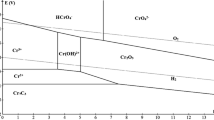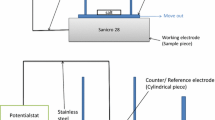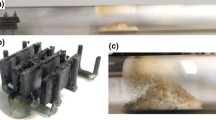Abstract
As in many other areas of material science there is an increasing need for computational tools predicting materials behaviour, also in high temperature corrosion. In many cases stability diagrams have been developed for the assessment of high temperature corrosion resistance of metallic materials where the potentially formed corrosion products are plotted as fields of stability as a function of the activities or partial pressures of the species in the reaction environment. One major drawback of these diagrams is that they only contain solid or liquid phases as reaction products, but in halogen induced high temperature corrosion volatile metal halides are also formed. In order to overcome this drawback, the present paper deals with the development of a new type of diagram for high temperature halogen corrosion which will be developed and discussed for the example of oxygen/chlorine environments and which will be named “dynamic” quasi-stability diagram. In part I of the paper, the basis for this new approach to the corrosion resistance assessment of metals under chlorine environments is established using the present understanding described in the literature. A comparison is made between the concept of the conventional stability diagram and the recently developed “static” quasi-stability diagram, where in the latter case the evaporation of the gaseous metal chloride phases is taken into account through the use of a critical metal chloride partial pressure of 10−4 bar, as a criterion distinguishing critical and non-critical corrosion conditions. Concluding from the existing knowledge, the fundamentals for the new improved approach are developed in the form of a “dynamic” quasi-stability diagram. This new type of diagram is based not only on thermodynamic considerations (as for the diagrams existing so far) but also on the products and reactants flow through a gas boundary layer formed on the material surface. As a consequence, in this approach the criterion for corrosion resistance is given in terms of a metal recession rate for dynamic conditions as encountered in most industrial applications. In part II diagrams of the new type will be established for the most common alloying elements, i.e. Fe, Ni, Mo, Cr, Si and Al, and a comparison with experimental data will be performed.















Similar content being viewed by others
References
D. Randall and S. Shoraka-Blair, An Evaluation of the Cost of Incinerating Waste Containing PVC (ASME, Research Committee on Industrial and Municipal Waste, New York, 1994).
S. Thongtem, M. J. McNallan, and G. Y. Lai, Corrosion 86 (NACE, Houston, 1986), p. 372.
C. Schwalm and M. Schütze, Materials and Corrosion 51, 34 (2000).
K. Hauffe and J. Hinrichs, Oxidation of Metals and Alloys 5, 87 (1971).
V. A. C. Haanappel, T. Fransen, and P. J. Gellings, High Temperature Materials and Processes 10, 91 (1992 ).
S. Doublet, PhD thesis, RWTH Aachen, Germany, 2006.
C. Schwalm and M. Schütze, Materials and Corrosion 51, 73 (2000).
R. Bender and M. Schütze, Materials and Corrosion 54, 567 (2003).
R. Bender and M. Schütze, Materials and Corrosion 54, 652 (2003).
P. L. Daniel and R. A. Rapp, Advances in Corrosion Science and Technology 5, 55 (1976).
K. Reinhold and K. Hauffe, Journal of Electrochemical Society 124, 875 (1977).
R. J. Fruehan, Metallurgical Transactions 3, 2585 (1972).
R. J. Fruehan and L. J. Martonik, Metallurgical Transactions 4, 2789 (1973).
E. A. Gulbransen, Corrosion 26, 19 (1970).
M. J. McNallan and W. W. Liang, Journal of the American Ceramic Society 64, 302 (1981).
M. J. McNallan, C. T. Kang, and W. W. Liang, Metallurgical Transactions 15A, 403 (1984).
N. S. Jacobson, M. J. McNallan, and Y. Y. Lee, Metallurgical Transactions 17A, 1223 (1986).
Y. Y. Lee and M. J. McNallan, Metallurgical Transactions 18A, 1099 (1987).
S. Y. Lee and M. J. McNallan, Journal of the Electrochemical Society 137, 472 (1990).
J. M. Oh, M. J. McNallan, G. Y. Lai, and M. F. Rothman, Metallurgical Transactions 17A, 1087 (1986).
M. J. McNallan, Y. Y. Lee, Y. W. Chang, N. S. Jacobson, and J. Doychak, Journal of the Electrochemical Society 138, 3692 (1991).
Acknowledgements
The financial support of the Bundesministerium für Wirtschaft und Technologie (BMWi) via the Arbeitsgemeinschaft industrieller Forschungsvereinigungen (AiF) under contract AiF No. 13266N is gratefully acknowledged. Furthermore, the authors would like to thank Dr. Rick Durham for proof reading the manuscript.
Author information
Authors and Affiliations
Corresponding author
Rights and permissions
About this article
Cite this article
Latreche, H., Doublet, S. & Schütze, M. Development of Corrosion Assessment Diagrams for High Temperature Chlorine Corrosion. Part I: State of the Art and Development of the Basis for a New Extended Approach. Oxid Met 72, 1–30 (2009). https://doi.org/10.1007/s11085-009-9147-0
Received:
Revised:
Published:
Issue Date:
DOI: https://doi.org/10.1007/s11085-009-9147-0




